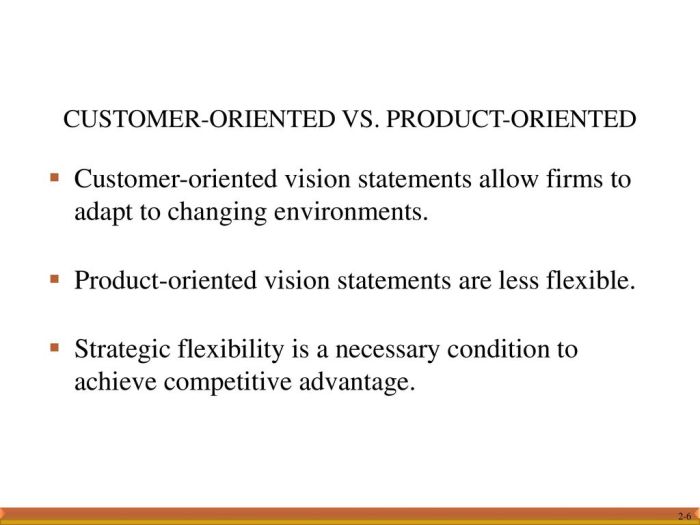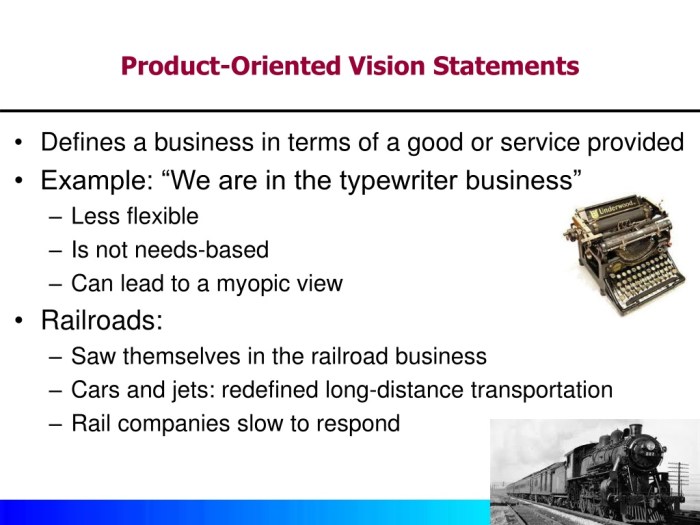Product-oriented vision statements provide managers with a vital tool for shaping the direction and purpose of their products. These concise, yet powerful statements serve as a guiding star, illuminating the path to success and ensuring alignment among team members.
By articulating a clear and compelling vision, managers can establish a shared understanding of the product’s goals, values, and aspirations. This shared understanding fosters collaboration, reduces uncertainty, and empowers managers to make informed decisions that align with the overall product strategy.
Definition and Overview
Product-oriented vision statements are concise statements that define the future state of a product. They articulate the product’s purpose, goals, and aspirations, providing a clear direction for managers and teams.
Effective product-oriented vision statements are:
- Inspiring: They motivate and engage stakeholders.
- Actionable: They provide clear guidance for product development.
- Measurable: They allow progress to be tracked and evaluated.
Benefits for Managers
Product-oriented vision statements provide numerous benefits for managers:
- Clarity and Direction: They provide a shared understanding of the product’s goals and objectives, aligning team efforts and reducing uncertainty.
- Decision-Making: They serve as a reference point for making strategic decisions, ensuring that they are aligned with the product’s long-term vision.
- Motivation and Alignment: They inspire and motivate teams, fostering a sense of purpose and shared ownership of the product’s success.
Elements of a Strong Product-Oriented Vision Statement

Strong product-oriented vision statements include the following elements:
- Customer Focus: They clearly define the target audience and their needs.
- Purpose and Values: They articulate the product’s purpose and the values that guide its development.
- Measurable Goals: They set specific, measurable, achievable, relevant, and time-bound goals.
- Actionable Insights: They provide actionable insights into the future direction of the product.
- Inspiring Language: They use clear, concise, and inspiring language that resonates with stakeholders.
Creating a Product-Oriented Vision Statement

To create a product-oriented vision statement, follow these steps:
- Understand the Target Audience: Define the target users and their needs.
- Articulate the Product’s Purpose: Determine the product’s reason for existence and its value proposition.
- Set Measurable Goals: Establish specific, measurable goals that align with the product’s purpose.
- Gather Stakeholder Input: Involve stakeholders to ensure alignment and buy-in.
- Craft the Vision Statement: Draft a clear, concise, and inspiring statement that encompasses the key elements discussed above.
Communicating and Using the Vision Statement

Communicating the product-oriented vision statement to stakeholders is crucial:
- Share with Teams: Regularly communicate the vision statement to teams involved in product development and management.
- Use as a Guiding Tool: Refer to the vision statement when making decisions or evaluating product progress.
- Monitor and Revise: Regularly review the vision statement and make revisions as needed to ensure it remains relevant and aligned with the product’s evolving needs.
Essential FAQs: Product-oriented Vision Statements Provide Managers With
What are the key elements of a strong product-oriented vision statement?
A strong product-oriented vision statement should be inspiring, actionable, measurable, and aligned with the company’s overall mission and values.
How can managers use product-oriented vision statements to guide decision-making?
By referring to the vision statement, managers can assess whether proposed decisions align with the long-term goals and aspirations of the product.
What are some common pitfalls to avoid when creating a product-oriented vision statement?
Common pitfalls include creating a statement that is too vague, uninspiring, or unrealistic. The statement should be clear, concise, and grounded in a deep understanding of the product’s purpose and market.